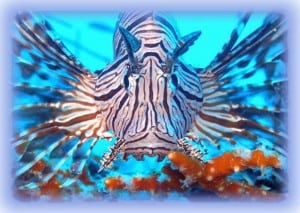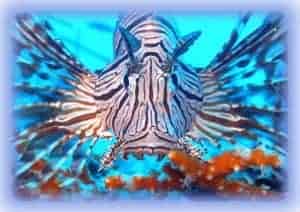
Ingredients:
Lionfishes belong to the scorpionfish family, which includes some of the most venomous fishes in the oceans. The lionfish has striped colours and spines of about 15 inches. They tend to take advantage of their camouflage to stalk their prey and when they are close enough, the lionfish quickly open their jaws to snap up their prey. Its prey are usually small fishes, shrimps and crabs but it feeds on almost anything that can fit in their mouths and they always swallow their food whole. They feed all day long which allows them to consume much more than the average fish!
The lionfish has a lifespan of about 5-10 years and its native to the tropical Pacific and Indian oceans, but have recently been found in the Atlantic Ocean and Caribbean Sea near our barrier reef, far from their natural home. They live among the coral reefs and shallow bays. This unique fish has few predators. Some fishes may try to eat them, but lion fishes’ venomous spines protect them from most predators.
This family of fish, including the lionfish, are external spawners. The male expels sperm immediately after the female releases her eggs, and the eggs are fertilized as they float in the water. These eggs and the newly hatched larvae drift in ocean currents for 25 to 40 days. Once the hatchlings are large enough to swim, they leave the currents to hide among corals and rocks. It probably takes 1 or 2 years for these hatchlings to reach breeding age. A female can lay one million eggs in a year.
Lionfishes are in no way threatened, but they have recently been found in the Caribbean and along the East Coast, as far north as Long Island, NY. The presence of these Pacific fishes in the Atlantic threatens many species that have not yet evolved defences to these voracious predators.
Our warm waters are being invaded as we speak. The dangers of the lionfish are yet unknown but from the facts we know about them, we can assume that they will soon become detrimental to our second longest Barrier Reef. They live long and multiply by millions, along with that they are not prone to many predators which give them maximum chance of survival and the oomph to live.
Although there is no written law as yet to enforce this, many of our local fishermen, dive masters and environmental organizations are now taking it into their own hands to kill the lionfish. It is nature’s law that the lionfish should not be a part of our ecosystem in such prevalence. Many different dive shops have begun doing this to preserve the reef.
Here at Hamanasi we have made the first step that we believe can save our reef system.  This picture is one of the lionfish that we have came up with to spread the awareness. We have created posters that we have placed in our dive shop and on our dive boats to show guides and guests. So if you see any lion fish, be sure to let your dive master know! It will make a safe dive today and help our reef system to last longer for more exiting dives in the future. The Hopkins Divers dive crew are monitoring and logging each fish killed, its location and the date since this fish is still under research in the US.
This picture is one of the lionfish that we have came up with to spread the awareness. We have created posters that we have placed in our dive shop and on our dive boats to show guides and guests. So if you see any lion fish, be sure to let your dive master know! It will make a safe dive today and help our reef system to last longer for more exiting dives in the future. The Hopkins Divers dive crew are monitoring and logging each fish killed, its location and the date since this fish is still under research in the US.
Here’s another idea! It has also been said that it makes a good meal for the people who have tried it; therefore the lionfish will soon be a part of many Belizeans’ menu. Think of a fish that is so plentiful with no season of when to catch!
